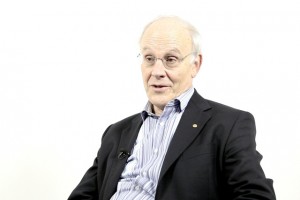Higher-Spin Gauge Theory
Physicist Xavier Bekaert on angular momentum, quantum tops, and supergravity
What are the differences between linear and nonlinear system response? How can we enable ion transport to be faster than in bulk electrolyte? Professor from the Department of Chemical Engineering at MIT, Martin Z. Bazant, speaks on the sources of nonlinearities in electrochemistry.
There are a lot of opportunities for using electrochemistry for materials processing. For example, making certain kinds of porous materials or other chemicals by electrochemical means. One of the largest industrial processes, aluminum production by the Hall- Heroult process, which is an electrochemical process. Electrochemistry clearly has a lot of importance in society, and is a major topic today in engineering. I would say that the understanding of electrochemical systems, although quite well developed for at least a century now, still has a lot of room to grow and advance.
Let me give just a few examples from my own research that I’ve been involved in that I think illustrate the principles I’ve just been describing. The first would be the topic of induced charge electroosmosis. Electroosmosis is an electrokinetic phenomena meaning that it is in the class of phenomena that involve the motion of particles or fluids in response to electric fields. Specifically when you have an electrochemical system you typically have a liquid electrolyte, which is a solution of positive and negative ions, cations and anion, and typically electrolytes are neutral, so there are roughly equal numbers of positive and negative elements. However, near charged surfaces, which might be the walls of a porous material, they’re always imbalances of positive and negative charges, which lead to the formation of the so-called double layer. This is where there’s a certain charge on the surface and then equal and opposite charges distributed in the electrolyte through this imbalance of positive negative charge.
One important source of nonlinearity comes from placing electrolytes in a porous material, or also in a microchannel or a lab-on-a-chip device, where you have surfaces with those double layers that I mentioned earlier playing a large role. In particular when you apply a large current through a porous medium or microchannel the effects of those surfaces can give you transport pathways essentially along the surface, so-called service conduction or electroosmotic flow, which allow the ions to get where they need to go faster than they would in a bulk system. This process can lead to the formation of very sharp discontinuities in ion concentration, which we call deionization shocks. That spontaneous sort of separation of high and low salt in a material due to the nonlinear dynamics of the transport is providing an opportunity for new kinds of separations in electrochemical processes.

Physicist Xavier Bekaert on angular momentum, quantum tops, and supergravity

Physicist Max Tegmark on the Doppler effect, redshift, nuclear fusion, and what happened 13.8 billion years ag...

Nobel Prize laureate David Gross on Rutherford experiments, asymptotic freedom, and the origin of the particle...